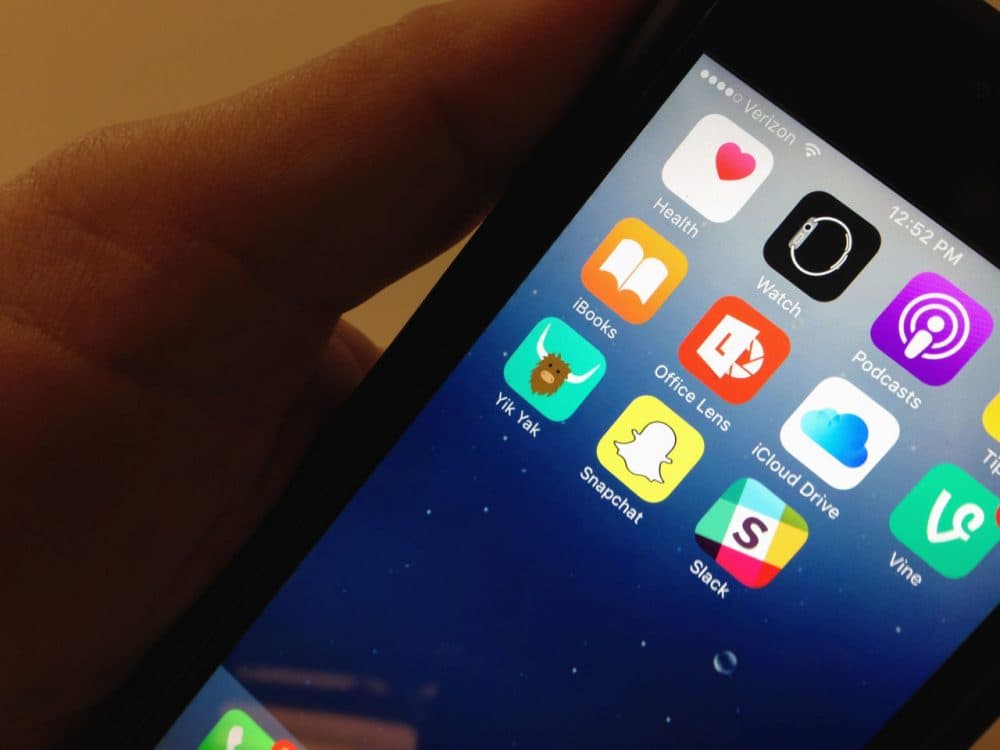Advertisement
Study Tracks Yik Yak App To Learn More About College Drinking And Drug Use

Consider this message, most likely posted by a college student in or around Brandeis University near Boston: “I just remembered I have a 4loko in my minifridge. Guess who’s getting sloppy day drunk tomorrow!”
Good luck finding the Four Loko fanatic. The post is from Yik Yak, an anonymous, free social media platform popular on college campuses.
Even so, a recent study analyzing Yik Yak posts gathered from 120 campuses suggests that tracking these messages does have an upside: Public health experts say it may ultimately help them learn more about issues like alcohol and substance use.
Over the span of one month, researchers at Johns Hopkins University and the University of Colorado at Boulder found 2,047 health-related yaks -- the term for posts on Yik Yak -- dealing with themes like smoking, drinking and drug use.
“Because it’s anonymous, people disclose things about themselves that they might not publicly post, either on Twitter or even necessarily to their doctors,” said Michael Paul, an assistant professor and founder of the Information Science Department at UC Boulder, in an interview.
While big data collected from social media has been used to study public health, such as influenza surveillance through Google search queries and Twitter, the field is relatively new and Paul's study is the first to look at public health using Yik Yak.
After collecting original data from the posts (they are public on the app) and replies within a five-mile radius of university campuses, the researchers used specific word clusters to sift through topics discussed on Yik Yak. Nearly 20 percent of those posts related to health, including alcohol consumption, tobacco smoking and illicit drug use.
To further drill down into the language used when discussing substances, the researchers coded a sample of 500 posts, assigning a category of either substance use, solicitation, social groups, addiction or information-seeking.
Tobacco aggregated the most posts tied to addiction, represented by yaks such as this: “It’s a funny realization when you realize that you’ll just never quit smoking cigarettes.”
The most commonly discussed substance was marijuana (“Anyone want to smoke? I got the weed and now I want some company”), with 117 standalone yaks (posts only about marijuana) and more than nine poly-substance use yaks (posts about marijuana and another drug).
“With Yik Yak, we were looking at patterns in substance use which are in some cases not at all monitored by existing government systems,” Paul said. “There aren’t necessarily large-scale official surveys on, say, attitudes towards tobacco or e-cigarettes, or monitoring for new drugs like bath salts, or if it does happen it can take literally years for official government resources to catch up.”
Studies like this one fill in the gaps. The federal government’s national survey on substance use is expensive and labor-intensive. Responses are collected over a year from phone calls to landlines and door-to-door visits, and it takes an additional year to analyze and put out the results.
This two-year lag is compounded by the fact that the questions themselves were developed in a health context that has inevitably changed in that time, and inherently reveal less fruitful data on personal information, Paul says. Research using big data is inexpensive, uncovers rich data, and is the most equipped at reporting on the most contemporary trends, such as the use of e-cigarettes, bath salts and synthetic adenoids.
But there are certainly drawbacks to an approach that casts a wide net on social media. Critics point out, for example, that not everyone is on Yik Yak or Twitter, and those that are might not be sharing truthful information.
Paul agrees with these confounding elements.
“There are a lot of factors that can definitely influence the results,” he said. “Sarcasm and joking — that alone is a really big challenge.” Some attention-seeking posters might not have in fact used methamphetamine, even though they've Yak'ed about it.
Plus, anonymity prevents confirmation of associations between geographical location and a cohort. For instance, a non-college student’s yak could be included in the mix of posts if the individual is within the five-mile radius of a message location on a college campus. Demographic properties within that cohort, such as gender, also could not consequently be correlated with particular findings.
There are implicit trade-offs when using social media platforms to analyze public health issues.
Clearly, they can't replace nationwide surveillance efforts by agencies like the Centers for Disease Control and Prevention. “But this may or may not matter,” according to Paul; beyond the notion of new study instruments displacing the old, he says the two schools of thought complement each other and have a symbiotic relationship.
Paul wants to continue peering into real-time conversations on social media platforms such as Twitter and Yik Yak to bolster traditional nationwide studies, standardize analysis of online public health messaging, and perhaps even catch new illicit substances coming onto the scene.
“If our goal is just to identify, say, a new drug, then sure epidemiologists would like to know who is using it,” Paul said. “It’s still useful to know.”
Madeline Rosenberg is a freelance journalist covering science, health and society, and is graduating in May from Brandeis University with degrees in public health and environmental studies.